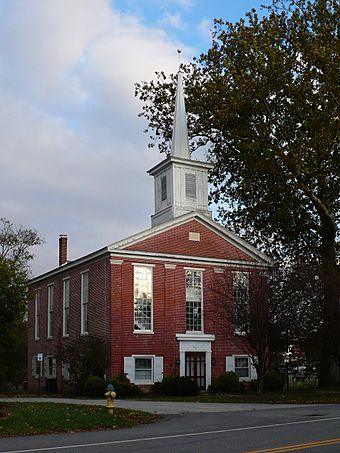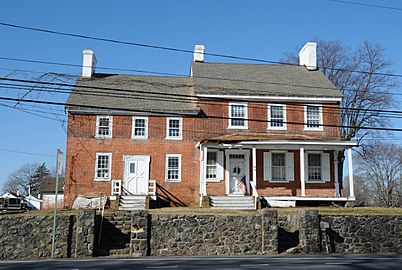Aiken's Tavern Historic District facts for kids
Quick facts for kids |
|
|
Aiken's Tavern Historic District
|
|

Pencader Presbyterian Church, November 2012
|
|
| Location | U.S. 40 and Glasgow Ave., Glasgow, Delaware |
|---|---|
| Area | 4.5 acres (1.8 ha) |
| Architectural style | Federal, Italianate |
| NRHP reference No. | 77000388 |
| Added to NRHP | December 6, 1977 |
The Aiken's Tavern Historic District is a special old area in New Castle County, Delaware. It includes the historic center of the village of Glasgow. This district is important because it was once home to Aiken's Tavern. This tavern was a very famous place during the American Revolutionary War. The district was added to the National Register of Historic Places in 1977. This means it is a protected site because of its history.
Where is Aiken's Tavern Historic District?
The district is located just west of where two main roads meet. These roads are U.S. Route 40 and Delaware Route 896. The historic area stretches along Glasgow Avenue for about 300 yards. Most of it is north of U.S. 40. It also includes a block of buildings called Mechanic's Row. These buildings are in the middle of the highway.
History of the Glasgow Area
The village of Glasgow grew up around an important crossroads. This area was first settled by a group of people from Wales in 1701. They were given a large piece of land. Soon after, a Presbyterian church was built. A tavern was also built and became known as Aiken's Tavern. It was named after one of its owners.
During the American Revolution, British soldiers came to Glasgow. Their leader, William Howe, took over the village. This happened after the Battle of Cooch's Bridge in September 1777. The British made the tavern their headquarters. They also used Pencader Church as a temporary hospital for their soldiers.
The crossroads became even busier after 1818. This was when the New Castle and Frenchtown Turnpike was finished. This turnpike is now U.S. Route 40. Many of the old buildings you see in the historic district today were built around this time. The original Aiken's Tavern building was torn down in 1832.
Important Buildings in the District
Many historic buildings are still standing in the Aiken's Tavern Historic District. These buildings help tell the story of the area.
- Pencader Presbyterian Church: This church was built in 1852. It stands on the same spot as an even older church. There is also an old wooden house next to it.
- The Middleton House: This house was built before 1818. There is also a small wooden shop building nearby.
- Mechanic's Row: This is a group of houses built around 1810.
- The "Manse": This is a three-story brick house. It was built around 1850.
Two other important buildings that were once part of the district are no longer there. These were the Glasgow Methodist Church and another wooden house near Pencader Church.




